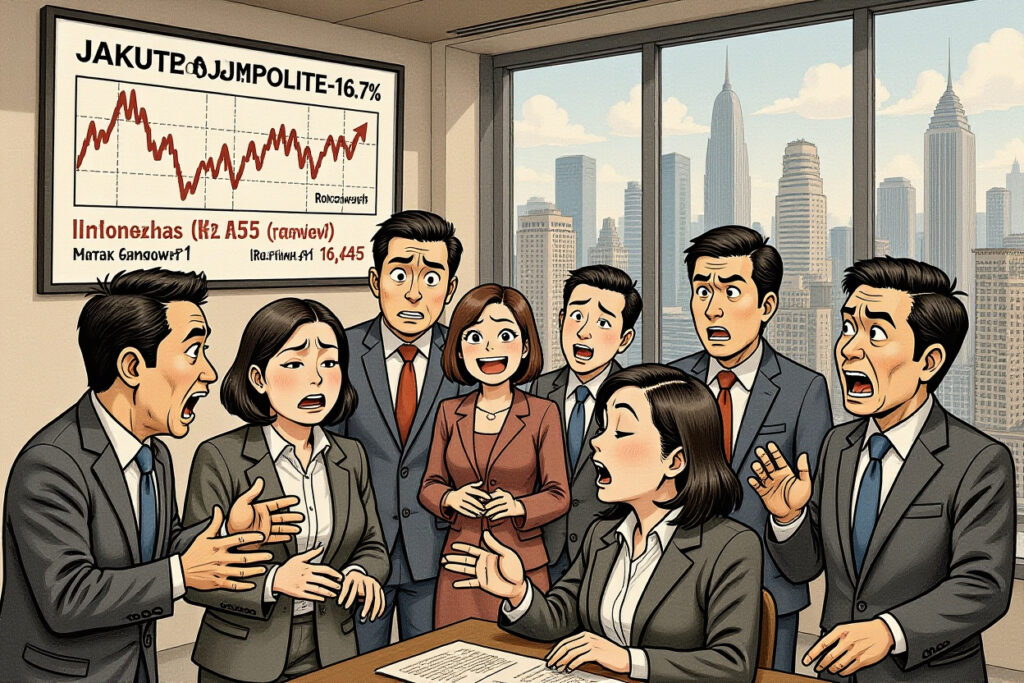The Myth of Federal Reserve Independence
Recent events have thrust the Federal Reserve’s supposed independence into the spotlight. With former President Donald Trump’s dismissal of Fed Governor Lisa Cook and Chair Jerome Powell’s unexpectedly dovish turn at the Jackson Hole symposium, Wall Street’s fears about the central bank’s politicization are intensifying. Against this backdrop, a deeper analysis reveals that the Fed’s current political repositioning is not an anomaly but a historical norm. The widely held belief in the Fed’s operational autonomy is, according to prominent geopolitical strategy firm Clocktower Group, a flawed concept—one born from a brief, mid-20th-century political consensus that has now unraveled.
The focus phrase, ‘political repositioning,’ perfectly captures the Fed’s current struggle. It is navigating a profound shift in the dominant US ideology, from neoliberalism to populism. This transition is forcing the institution to recalibrate its priorities, moving away from a singular focus on inflation toward a more politically sensitive balance that includes employment and growth, even at the risk of higher prices. This political repositioning is an inevitable response to a changed America.
A Legacy of Subservience: The Fed Before 1980
From its inception in 1913, the Federal Reserve was a product of political compromise, designed more as a financing arm for the Treasury than an independent monetary authority. Its history is a chronicle of yielding to executive power and broader political currents.
The Treasury’s Instrument
During World War I, the Fed provided low-interest discounting for government debt. The Great Depression saw President Franklin D. Roosevelt use emergency powers to strip the Fed of its gold standard constraints, placing the Treasury in complete control of the monetary base. World War II cemented this relationship, with the Fed explicitly committing to pegging interest rates low to minimize the government’s borrowing costs. Fed Chair Marriner Eccles famously admitted the institution was merely ‘executing the decisions of the Treasury.’
The Illusion of the 1951 Accord
The 1951 Treasury-Fed Accord is often hailed as the birth of modern Fed independence, ending wartime rate controls and allowing the Fed to prioritize inflation control. However, this independence was nominal and quickly eroded. President Lyndon B. Johnson aggressively pressured Fed Chair William McChesney Martin to keep rates low to fund the Vietnam War and his ‘Great Society’ programs. Historical accounts describe a confrontation at Johnson’s Texas ranch in 1965 over a proposed rate hike. By 1967, a compromise was struck: the Fed eased policy in exchange for Johnson pushing a tax increase through Congress.
President Richard Nixon took political interference to a new level. He appointed Arthur Burns as Fed Chair in 1970 with the explicit expectation of loose monetary policy. Nixon applied relentless pressure through over one hundred private meetings during his first term. The infamous ‘Nixon Tapes’ captured him directly instructing Burns to expand the money supply to aid his 1972 re-election campaign. Subsequent presidents Gerald Ford and Jimmy Carter, while more subtle, continued this tradition of influence.
The Political Reality of Inflation
Beyond direct White House pressure, the Fed was constrained by the broader political mood. Arthur Burns’s 1979 speech, ‘The Anguish of Central Banking,’ is the definitive commentary on this limitation. He argued that the persistent inflation of the 1970s was not a failure of monetary management but a deeper political reality: American voters and their elected representatives consistently prioritized employment, growth, and welfare over price stability. Every attempt to tighten policy caused immediate, tangible pain for families and businesses, triggering a backlash from Congress and the public. The long-term benefits of conquering inflation were abstract and distant. Burns concluded that inflation persisted due to a ‘strong and pervasive political preference’ for expansionary policies. His insight underscores that without popular support, a central bank cannot tame inflation, no matter how ‘independent’ it claims to be. This was the ultimate proof that the Fed’s role is inherently political.
The Neoliberal Construction of Independence (1980s–2010s)
The stagflation of the 1970s created the political space for a radical shift. A public weary of high inflation turned rightward, embracing ideas of small government, deregulation, and market-oriented reforms. Ronald Reagan’s landslide victory in 1980 symbolized this shift, placing fiscal conservatism and anti-inflation zeal at the core of US economic governance.
Volcker and the Political Mandate
In this new climate, central bank ‘independence’ was redefined as an institutional bulwark against politically motivated money printing. Its primary mission was ensuring price stability. Paul Volcker’s appointment as Fed Chair in 1979 (by Jimmy Carter, but upheld by Reagan) and his drastic interest rate hikes were the embodiment of this political repositioning. His actions had the necessary political cover from a public and a president who supported the painful disinflationary process.
Independence as a Political Construct
This newfound ‘independence’ was never apolitical. It was a political construct designed to advance neoliberal priorities. By prioritizing low inflation—which clearly benefits creditors and capital owners—over full employment—a core goal of pro-labor policies—the Fed’s independence became a mechanism to insulate policymaking from redistributive demands. It was not a return to neutral technocratic governance but a product of the socio-political consensus of the 1980s.
The Greenspan Era and the Seeds of Crisis
Alan Greenspan’s long tenure from 1987 to 2006 reinforced this model. His era, known as the ‘Great Moderation’ for its stable growth and low inflation, burnished the Fed’s image as a technocratic institution above the political fray. Beneath the surface, however, the Greenspan Fed actively championed neoliberal financial deregulation, turned a blind eye to speculative bubbles, and fostered a policy environment extremely favorable to asset holders. The seeds of the 2008 Global Financial Crisis were sown during this period of ‘market-friendly independence.’ This version of central banking was exported globally in the 1990s and 2000s through IMF loan conditions and the ‘Washington Consensus,’ becoming synonymous with ‘credibility’ in international markets.
The Waning Consensus and the Return of Political Pressure (Post-2010)
The 2008 Global Financial Crisis (GFC) began the gradual erosion of the neoliberal consensus that had dominated US economic policy since the 1980s. Soaring income inequality, stagnant real wages, and the public perception that ‘Wall Street was saved while Main Street was left to pay’ fueled a populist turn in American politics throughout the 2010s.
The Yellen Fed and a Shift in Priority
This political reshaping weakened support for old orthodoxies—fiscal austerity, deregulation, and limited government—and replaced it with a public demand for policies that directly support workers and households. The Fed under Chair Janet Yellen reflected this evolution. Her dovish stance could be explained by traditional macroeconomics (low inflation and a fragile recovery), but the deeper socio-political environment was crucial. Yellen constantly emphasized the importance of a ‘strong labor market’ and highlighted the human cost of unemployment, echoing public skepticism of ‘trickle-down economics.’
The Pandemic and the ‘Transitory’ Inflation Choice
The Fed’s actions during the COVID-19 pandemic further highlighted its political repositioning. As inflationary pressures built from late 2020 into 2021, the Fed was slow to tighten policy, insisting inflation was ‘transitory.’ This was a deeply political calculation. Millions of families were still recovering from the pandemic’s shock. Moving too quickly to hike rates could easily be perceived as callous and indifferent to the working class. In essence, the Fed’s shifting priorities aligned with the US public’s strengthened redistributive and pro-labor demands over the previous decade. This wasn’t a partisan ‘left turn’ but an adaptation to the social and political atmosphere. The decision to tolerate higher inflation for longer was a fundamental aspect of its political repositioning.
The Inevitable Reshaping Under Trump and Beyond
If the Fed’s independence in the 1980s was possible due to a strong political consensus around neoliberal priorities, its erosion during the Trump era reflects the collapse of that consensus and the rise of populism as a dominant US political force.
The Loss of Political Capital
The Fed’s ability to remain independent has always depended on its political capital—its legitimacy in the eyes of the public and elected officials. In the early 1980s, Volcker’s policies succeeded because the American public had lost patience with runaway prices and was willing to support a painful economic rebalancing. Independence was sustainable because it aligned with the median voter’s preference. By the 2010s, the Fed carried the baggage of an ‘elite establishment institution’—an unelected technocratic body that had bailed out Wall Street during the GFC while ordinary families suffered foreclosures, wage stagnation, and widening inequality. Populists on both the left and right questioned its legitimacy. With public trust at historic lows, the Fed’s political capital evaporated. No longer protected by a bipartisan consensus, it was exposed to public hostility and presidential attacks, lacking the legitimacy that shielded it during the Volcker-Reagan era.
The Lesson from the Judiciary
Those who believe the Fed can remain independent in this environment need only look at the weakened state of judicial independence. The reported event in March 2025, where Attorney General Pam Bondi allegedly arranged a highly controversial, campaign-style speech for Trump at the Department of Justice headquarters, would mark an unprecedented politicization of that institution. If the DOJ—long considered one of the most insulated institutions—can be shaped by populist politics, then the Fed, whose structure is far more susceptible to presidential appointments, pressure, and public opinion, is even less equipped to resist such forces. This comparison underscores the powerful external pressures driving the Fed’s political repositioning.
A Structural Shift, Not a Personal Failure
This reshaping is not due to weakness in Chair Jerome Powell’s leadership or a sudden ideological shift within the Fed. It is the product of structural forces in American politics. When the preferences of the median voter change, the independent space for technocrats shrinks. In a political system dominated by populism, the Fed can no longer plausibly act as a contrarian, inflation-fighting ‘minority institution.’ It is now, willingly or not, participating in a populist agenda that prioritizes growth, jobs, and short-term prosperity, even at the cost of long-term inflation risk. The fate of Fed independence is not being decided in FOMC meeting rooms but by the broader social and political currents of American democracy. This ongoing political repositioning is the new reality.
Key Takeaways and Moving Forward
The Clocktower Group’s analysis provides a crucial framework for understanding the Federal Reserve. Its independence was always a conditional privilege, not a permanent right. The current era of populism demands a new alignment from the institution, one that prioritizes different economic outcomes than the neoliberal era did. For investors, this means recalibrating expectations. The Fed’s reaction function will be slower on inflation and more sensitive to labor market conditions than in the past. The ‘Fed put’ is now influenced by political sentiment as much as by market volatility.
The great myth of apolitical central banking has been debunked. The Fed’s journey is a mirror of America’s own political evolution. To stay ahead of monetary policy shifts, market participants must look beyond economic data and closely analyze the political landscape. Understanding this deep-seated political repositioning is no longer optional—it is essential for navigating the future of finance.
– Analysis adapted from Clocktower Group’s Strategy Department




